Why white spots appear on cucumber leaves and what to do to save the crop
White spots on the leaves indicate that the plant is infected with pests or parasites. Such symptoms can be observed when growing cucumbers in a greenhouse and in the open field. Before removing stains, you need to find out why plaque has appeared and find the right treatment.
The content of the article
Causes of white spots on cucumber leaves
Specialists highlight a list of diseases characterized by the appearance of white spots on the leaves of cucumbers... Most often, plants grown in a greenhouse or greenhouse are covered with white bloom. Identification of the cause of such a pathology begins with an examination of the bush. Spots on the leaves and stems of a cucumber may indicate the presence of disease.
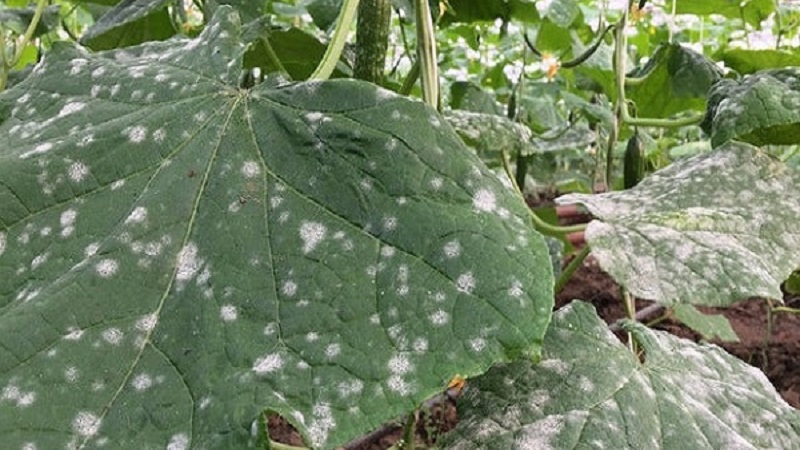
Anthracnose
Causes of infection - fungal microorganisms Colletotrichum... They get to healthy plants with the help of wind, insects, through unharvested plant remains from the last season. Cucumbers can get sick with anthracnose throughout the growing season. Symptoms appear on leaves, stems and fruits.
Young plants are more susceptible to infection anthracnose, their stems are covered with brown depressed spots. The affected areas become thinner and broken.
At the very beginning of infection, the leaves brighten, become covered with white spots, which eventually acquire a brown tint. In the open field, the affected leaves dry out, in the greenhouse they begin to rot.
Oblong brown spots appear on the fruit, so the spores of the fungus get inside. Cucumbers darken, become bitter, rot.
Attention! Anthracnose spreads quickly and results in less harvest. Untimely treatment can lead to 100% loss of yield. The disease spreads to other plants in the neighborhood.
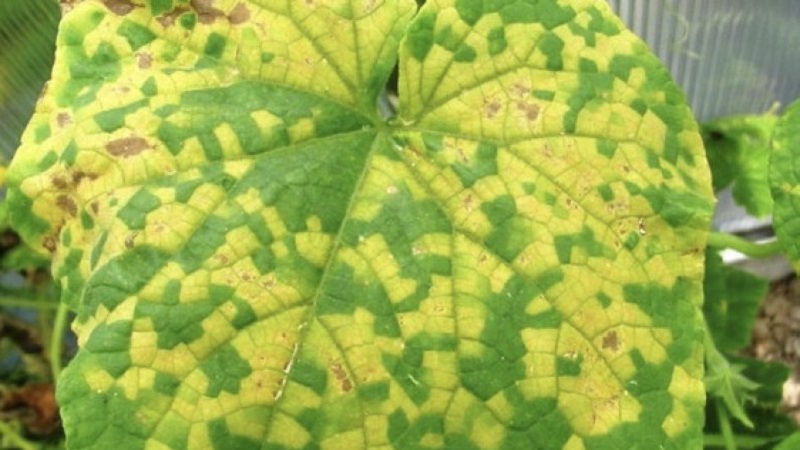
The causes of the disease can be infected seeds, plant debris, as well as fungus, which has been preserved on the walls of the greenhouse. Comfortable conditions for the development of the disease are high humidity and high temperature. Therefore, anthracnose most often affects plants in greenhouses covered with film.
Ascochitosis
This is an infection of the seeds with fungal spores that slow down the growth of cucumbers.... Most often, greenhouse plants suffer from such microorganisms at the very beginning of summer. Lack of heat and trace elements leads to a decrease in plant immunity. On weakened specimens, the disease develops. Mycelium (mycelium) is not afraid of low temperatures. It appears during the period of fruiting, in rare cases - during the formation of the stem.
First, the spores penetrate into the seeds of the culture, they begin to infect the upper tissues of the cucumber after planting in the soil. The vascular system does not suffer, so the plant continues to grow, albeit weaker.
During the appearance of leaves, the fungus increases its population and begins to infect tissues and blood vessels. The disease progresses higher up the stem and microorganisms infect other leaves.

With the appearance of cucumbers, the mycelium penetrates into the fruits: white spots appear on them, which eventually begin to rot.
Microorganisms can reproduce sexually and asexuallytherefore they attack all weak cucumbers that grow nearby. The disease can be recognized, it is necessary to carefully examine the first leaves: at the infected edges turn yellow and dry out.
White mosaic
It is a viral disease that lives in the soil and remains viable for over 10 years.... It affects the tissues of cucumbers at the cellular level and leads to the destruction of chlorophyll. The virus inhibits the process of photosynthesis, due to which the plant cannot receive nutrients and dies.
White mosaic affects the plant at any stage of development... Diseased seedlings grow poorly and do not take root after transplanting into the ground.

Infected cucumber leaves are covered with yellow spots near the veins... With the development of the disease, the spots increase in size and merge. The plant stops growing, the leaves turn yellow and dry out.
If the disease manifests itself during fruit ripening, some flowers die, and tuberosity appears on the surface of the cucumbers. Such fruits are suitable for consumption, the virus itself does not cause any harm to humans, but the plant can die within 2 weeks after infection.
Powdery mildew
With powdery mildew cucumbers are covered with a white bloom resembling flour... Over time, spores infect a whole leaf, after which it withers and turns yellow. The first to suffer are those leaves that are closer to the ground. In case of untimely treatment, the disease spreads, rising upward and infecting the upper leaves, flowers and even fruits. The plant can completely die, or it slows down significantly in development.
The disease most often manifests itself in early summer.when the temperature is low and the humidity is high. This environment is most comfortable for spore breeding.
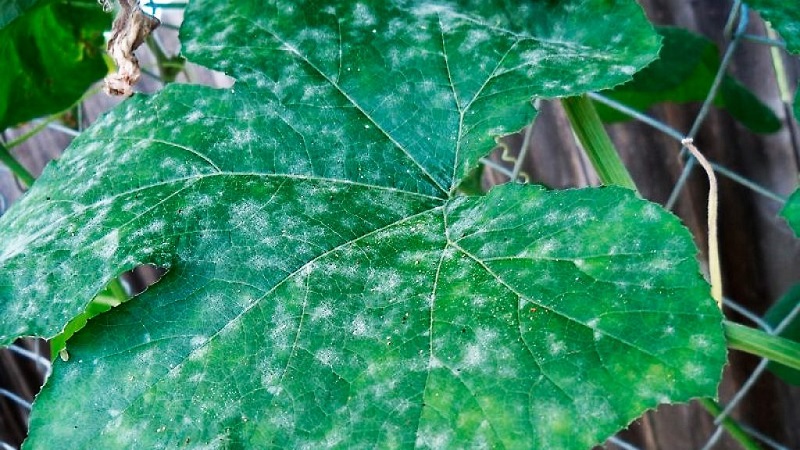
Causes of plant infection with powdery mildew:
- improper watering - the use of cold water at a low air temperature;
- lack of lighting in the greenhouse;
- draft;
- deficiency of essential microelements or an excess of nitrogen fertilizers;
- violation of crop rotation - growing cucumbers in the same area for several years in a row.
Spider mite
Inhabits soil and plants, impairing the quality of growth and quantity of the crop. Mites winter on the walls of greenhouses, in the ground and fallen leaves. When the soil warms up, pests crawl out of the soil and attack young plants.
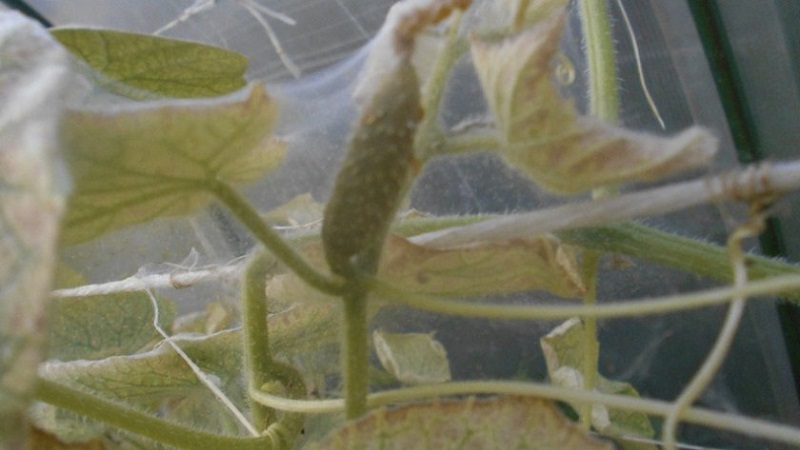
The main causes of ticks - high temperature and dry air. The insect can get on cucumbers from other plants in the neighborhood in a gust of wind or catching on clothes, on a watering can when watering.
Attention! Spider mites can infect cucumbers with gray mold spores.
The danger is that the tick feeds on sap from plant cells... The surface of the infected leaves is covered with white spots and dense cobwebs. The plant loses nutrients and cannot resist infections.
What to do to save the harvest
Finding the disease in time can save the crop... If the lesion is small, the infected leaves are removed and the healthy ones are treated with soapy water. But if the parasites have damaged most of the plants, they use chemicals.
In the greenhouse
Humidity is high, and for many parasites, this environment is ideal for reproduction.... Treatment for parasites in greenhouse conditions begins with airing. Watering is stopped for 1 week. When the humidity level decreases, cucumbers are treated with folk remedies:
- 1 liter of liquefied cow manure is mixed with water (25 liters) and Art. l. urea, the solution is suitable for irrigation of leaves;
- spraying with a solution of potassium permanganate and copper sulfate helps in eliminating many diseases that develop due to fungi.
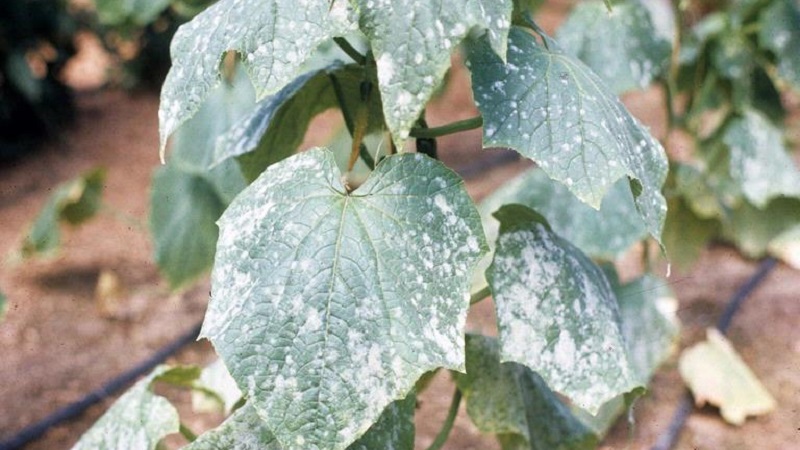
In case the use of folk remedies did not give results, plants are treated with chemicals - "Fundazol", "Topaz".
Important! Before using, be sure to read the instructions - some chemicals cannot be used in the greenhouse.
Check all plants when symptoms appear.growing in the neighborhood. If the sick bush could not be saved, it is dug up and destroyed.
In the open field
Infection most often occurs through soil or air... Disease therapy in the garden is identical to that in greenhouse conditions.
A sick bush cannot be watered for 4-5 days... It is recommended to loosen the soil to normalize air intake and prevent root rot. For cucumbers to grow stronger and fight disease, they need strong immunity. For this, fertilizing is carried out 5-6 times per season.
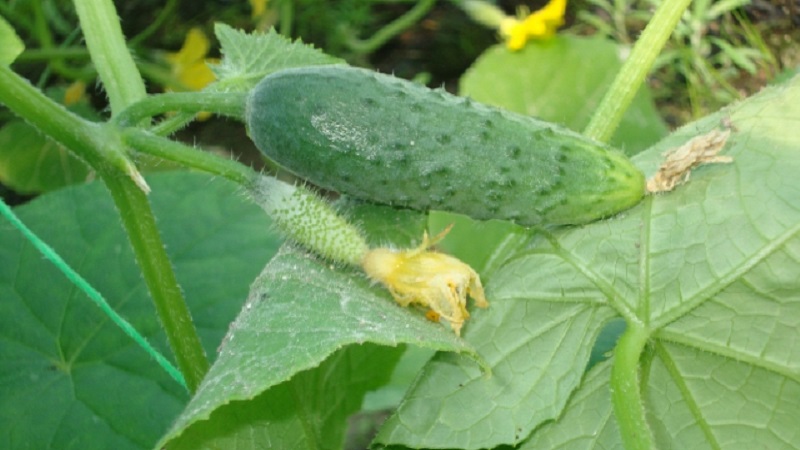
Severely damaged plants can be cured using chemicals... In the open ground, it is allowed to use the preparations "Fundazol", "Topaz" and "Zaslon". For spraying plants, 1 ampoule is diluted in 8 liters of water. It is recommended to carry out the treatment with chemicals in the evening so that they do not evaporate under the sun.
Attention! Since the disease is spreading quickly, act immediately.
Prevention measures
 Diseases of cucumbers are easier to prevent than to deal with their consequences. Prevention starts with the right soil preparation and greenhouses... To do this, in the fall, all plants are removed by the roots and burned. The earth is dug up, the holes are watered with a solution of potassium permanganate. The greenhouse is ventilated for 2-3 days.
Diseases of cucumbers are easier to prevent than to deal with their consequences. Prevention starts with the right soil preparation and greenhouses... To do this, in the fall, all plants are removed by the roots and burned. The earth is dug up, the holes are watered with a solution of potassium permanganate. The greenhouse is ventilated for 2-3 days.
It is recommended to treat the seeds before sowing... To do this, they are soaked in a solution of copper sulfate or potassium permanganate. Young shoots should be protected from temperature extremes and properly watered. Weeding should be done regularly as many pests are spread through weeds.
Compliance with crop rotation - an important method of preventing diseases of cucumbers. The land on which the cucumbers grew last season is not suitable for replanting, so this area should be used for cucumbers after 3-4 years.
To prevent viral diseases it is recommended to water the plant with a solution of copper sulfate mixed with ash. The presence of ash in the soil will protect the plant from many other pathogens.
Helpful advice from experienced farmers
Every Farmer Uses Their Secrets To Get A Rich Harvest... Tips from experienced gardeners to help you grow healthy cucumbers:
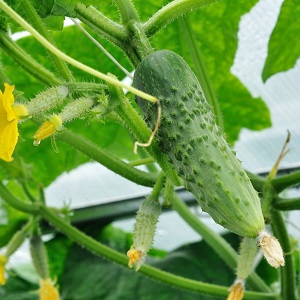 From the beginning of July, it is recommended to process cucumbers with an onion peel composition. To prepare 10 liters of boiling water, take 0.7 liters of onion husks, bring to a boil and leave for 24 hours. Dilute the resulting mixture with water in a ratio of 1: 4. Spray the plant with the solution and water it 2-3 times a month.
From the beginning of July, it is recommended to process cucumbers with an onion peel composition. To prepare 10 liters of boiling water, take 0.7 liters of onion husks, bring to a boil and leave for 24 hours. Dilute the resulting mixture with water in a ratio of 1: 4. Spray the plant with the solution and water it 2-3 times a month.- During the flowering period, water the cucumbers with a mixture made from 2 liters of whey and 150 g of sugar.
- To eliminate pests during growth, use a solution of iodine and laundry soap. To do this, dilute 30 drops of iodine in 10 liters of water, add 20 g of laundry soap and, if desired, 1 liter of milk. Spray once every 10 days.
Conclusion
Cucumbers are an unpretentious plant that grows well in open ground and greenhouse conditions. However, this crop is susceptible to pests and parasites. Prevention and timely treatment will help prevent the consequences of diseases and enjoy a rich harvest.